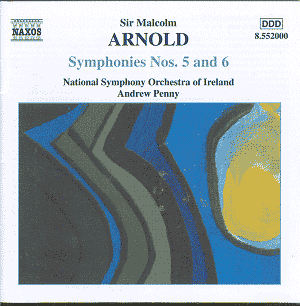Sir Malcolm ARNOLD
Symphony no 5, op 74 (1961)
Symphony no 6, op 95 (1968)
 National Symphony Orchestra
of Ireland/Andrew Penny
National Symphony Orchestra
of Ireland/Andrew Penny
Recorded in the National Concert Hall, Dublin, 24-25 January 2000
 NAXOS 8.552000
[57:17]
NAXOS 8.552000
[57:17]
Crotchet
AmazonUK
AmazonUS
Amazon
recommendations

The splendid Naxos cycle of Arnold's symphonies has now reached numbers five
and six, in performances and recordings which reveal the same consistency
of excellence as the five already released (numbers one and two on Naxos
8.553406; three and four on Naxos 8.553739; and nine on Naxos 8.553540).
In passing, it's worth noting how prodigious was Arnold's output: in the
seven years between 1961 and 1968 the composer moved from opus 74 to opus
95, as well as providing a huge number of film scores (to which he did not
assign opus numbers). He has always considered his symphonies to be the music
by which he should be judged. For all their frequent outbursts of jollity
and ebullience they have their dark side, too, which became more pronounced
as the cycle evolved, and as is evident from these two works. One or two
other general points need to be made. In being dazzled by his melodic fertility
and brilliant orchestration, we can easily overlook two other aspects of
his remarkable powers as a composer. Nowadays, in their search for rhythmic
variety and vitality, composers indulge (some might say, over-indulge) in
frequent changes of time-signature. Arnold had no need of such adventitious
props: if a piece was in 4/4, then that's where it stayed, yet within such
a fixed framework he achieved a constant flow of rhythmic shifts. A second
easily overlooked virtue is his mastery of form: he showed that the age-old
conventions of sonata movement, rondo, binary and ternary forms and so forth
are still capable of endless adaptations.
All I need do here is to pick out some of the abundant felicities of these
two symphonies. The Fifth has a characteristically elusive first movement:
but what at first seem wispy, disjointed fragments are worked up into a
convincing whole. The second movement contains one of Arnold's most haunting
melodies which gives way to a rather more dissonant and disturbed development
section before reasserting itself in a tranquil ending (one minor criticism
here of Penny's reading: a typical Arnold downward glissando from
double basses is virtually eliminated). The bustling scherzo, with its slinky
trio section, is pure fun. The seemingly innocent 'pipes and drums' motif
of the finale has disturbing undercurrents (I feel that Penny underplays
the strange counter-melody which appears on its later manifestations; also
the re-emergence at the coda of the slow movement theme 'in full technicolour
'is to my taste a little too matter-of-fact).
The Sixth is a generally darker piece. It's amazing what Arnold can do with
seemingly unpromising material: in the first movement, for instance, an obsessive
two-note phrase; and in the second, mere scales. The second, slow movement
cleverly incorporates a central section which does duty as a scherzo and
is particularly notable for his deft handling of percussion. The robust theme
of the rondo finale is brilliantly presented in a number of guises.
This disc will have an appeal well beyond the confines of the Malcolm Arnold
Society.
Adrian Smith
Visit the Malcolm Arnold
Website

